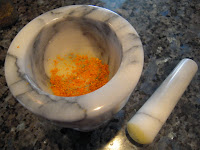PART 2: THE COOKING
So now what to do? After all that I didn’t want to throw it away, but I didn’t want to eat it, either. Then it occurred to me that it was very much like country ham. Now it was no longer Ruined Duck Prosciutto, but Salt-Cured Wild Duck Breast!
It would be fine if used as you would country ham! I just treated it as if it was a country ham, soaking it for many hours and changing the water several times to draw out the salt. With it I made a Duck Carbonara and a Wild Duck Mousse. And they weren’t too bad.
CARBONARA MADE WITH PROPER DUCK PROSCUITTO
(or with SALLY'S SALT-CURED WILD DUCK BREAST)
For Carbonara, I like to use the technique set out by Biba Caggiano in Trattoria Cooking1. It’s simple, fast, and works every time.
Here’s the strategy, formula, and technique. The proportions are more or less, give or take. Multiply or divide as you wish:
Here’s the strategy, formula, and technique. The proportions are more or less, give or take. Multiply or divide as you wish:
For two, beat 2 small eggs in your serving dish. Let it sit on the counter while you do the rest.
Heat 1-2T olive oil in a large frying pan, add two cloves of garlic, and cook over low heat until they are golden. Remove from pan. (Caggiano has you discard the garlic, but don’t do that. Mash them up with a little kosher salt and add them to the eggs). Raise heat to medium, add about 3 or 4 oz minced duck prosciutto (or soaked and drained salt-cured wild duck breast), and cook for about 15 seconds. Turn off the heat and leave the pan where it is.
Get your pasta going: fill a large pot with salted water and bring it to a boil. Add about 1/3 to ½ lb. pasta and cook, uncovered, until pasta is al-dente. Drain it, reserving some of the water in case you need to moisten it up later, and add it to the frying pan with the duck proscuitto. Season with salt, if needed, pepper and a pinch of dried red pepper flakes, mixing over low heat until all the pasta is coated with the sauce. Be sure it stays hot. It must be hot for the next step.
Put the hot pasta and sauce into the bowl with the eggs and garlic, along with ½ c freshly grated parmesan cheese (or a mix of romano and parmesan), mixing it quickly and thoroughly. Serve right away with more freshly grated parmesan or romano cheese.
DUCK MOUSSE with a HINT OF ORANGE
For this, I used Gourmet’s Basic French Cookbook, Techinques by Louis Diat2 and the Larousse Gastronomique2, as my guide (as I usually do for French food), except I substituted softened butter for the sauce velouté called for in the recipes.
Here’s the strategy, formula, and technique. The proportions are more or less, give or take. Multiply or divide as you wish:
Here’s the strategy, formula, and technique. The proportions are more or less, give or take. Multiply or divide as you wish:
Makes about 2 c.
If you’re using duck prosciutto, soak it in cool water for a while, until it softens up a bit. If using duck salt bombs, soak them, changing water occasionally, for several hours, until they’re edible. You’ll need about 1 c coarsely chopped duck.
Put the duck in a food processor with 1 chopped shallot and ½ tsp fresh thyme and chop until very fine (if you don’t have a food processor, use a knife). Add a tablespoon or two of warm water, as needed, and process again to form a thick paste. Mix in 2 T softened butter.
Rub duck mixture through a sieve. Be sure to do this, as there will be a lot of tissue and sinew you’ll want to get rid of.
Zest one orange, and then juice it. Strain the juice and in it soften 1T gelatin. When it begins to soften, blend it into the duck mixture. Mix in minced orange zest, as well as the ground zest from three strips of dried orange peel*. Fold in ½ c heavy cream, whipped until stiff. Season with white pepper. It should be salty enough, but if it’s not, then add salt
too. Transfer to serving dish and chill.
Serve with a sweet and savory jam, such as pepper jelly, onion jam, or chutney, and some kind of pickles, such as pickled watermelon rind or cornichons. Serve on thinly sliced French bread or crackers.
*To make dried orange peel, leave long strips of orange peel, with any of the bitter white underside scraped away, on a plate until completely dry, for several hours or overnight. Store in a dry glass jar, and grind with a mortar and pestle.
WHAT WE DID WITH THE REST OF THE DUCK
 |
| Made a nice, rich broth, |
2Diat, Louis. Gourmet’s Basic French Cookbook, Techniques of French Cuisine. New York: Gourmet Books, Inc., 1961.
3Lang, Jenifer Harvey Lang, ed. Larousse Gastronomique. New York: Crown Publishers, 1984 & 1988.













No comments:
Post a Comment